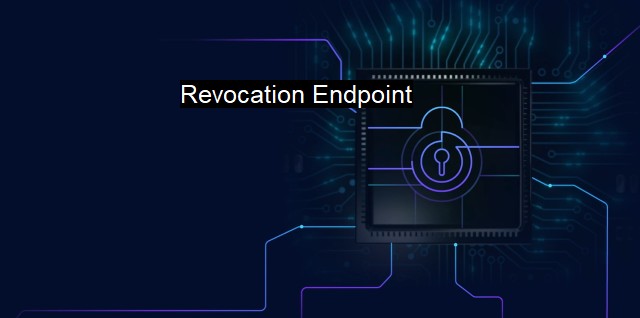What is Revocation Endpoint?
Understanding the Importance of Revocation Endpoint in Cybersecurity: An Overview of Digital Certificates and the SSL/TLS Protocol
"Revocation Endpoint" is a term related to the world of cybersecurity and denotes a specific feature within a cybersecurity protocol that helps enhance the security framework of an application or software system. Primarily associated with OpenID Connect and OAuth 2.0- two modern-day protocols concerning internet identity and credential management, the revocation endpoint is central to the process governing the control, usage, and removal of access tokens.Fundamentally, the term "revocation" means cancellation or withdrawal in the wider sense, hence revocation endpoint is all about the cancellation or withdrawal of an access token or refresh token i.e. authorization grants that provide certain user or entity the access to a particular system or resource.
Access tokens engender individual users or entities with the defined accessibility and usage rights to access based on the assigned privileges. after an access token has been granted, there can be two key security issues. The first one pertains to token expiration and the requirement to refresh it, while the second grapples with more severe circumstances where one might have to completely revoke or withdraw the access because of potential security threats.
Therefore the role of a revocation endpoint becomes momentous. The revocation endpoint is an address (URL) that handles token revocation requests. Precisely put- it's the URL that the client communicates to, to revoke its access.
With OpenID Connect and OAuth 2.0, a revocation endpoint is specified which provides clients the latitude to directly communicate with the servers to invalidate the tokens for the purpose of halting access. Ergo, if a token is compromised, or if there is a need to prevent any further usage of the token for whatever the security rationale might be, a revocation request can be directly sent to these endpoints with the token that requires to be invalidated or, in other words, to revoke its access.
Revocation endpoint has also proved effective in boosting security because it encourages more conservative expiry timeframes for access tokens and refresh tokens. more efficient usage and then disposal of access tokens add an extra layer of security within the system. This characteristic minimizes potential vulnerabilities related to token compromise, misuse, replay attacks and even Man-in-the-Middle (MitM) interception.
The aspect of revocation endpoint becomes especially important with respect to the rise in complexity and frequency of cyber threats. In the highly interconnected digital landscape, unauthorized access through token misuse is a severe cybersecurity threat that can lead to losses both financially and reputational.
Antivirus software, another integral part of any cybersecurity setup, works tandemly with token revocation. If a breach is detected, antivirus software can isolate the threat while the token revocation efficiently works in invalidating the tokens, cutting off the access and thus mitigating the potential damage.
The positioning of a revocation endpoint within the authentication and authorization mechanism defines its essential function, in bolstering system integrity and security, and maintaining user trust. To achieve secure digital experiences, revocation endpoint thus forms an indispensable part of any cybersecurity infrastructure and processes, ensuring the security of the digital resources, data and applications.

Revocation Endpoint FAQs
What is a revocation endpoint?
A revocation endpoint is a service that allows you to revoke digital certificates or security tokens in a secure and controlled way. It is used to protect your organization's networks and assets from unauthorized access by invalidating credentials that may have been compromised, lost, or stolen.Why is a revocation endpoint important in cybersecurity?
A revocation endpoint is critical in cybersecurity because it helps detect and mitigate the risk of unauthorized access to your organization's networks or data. It allows you to quickly and easily revoke access for users or devices that may pose a security threat. Without a revocation endpoint, security breaches may go unnoticed or unresolved, leaving your organization vulnerable to threats.How does a revocation endpoint help with antivirus protection?
A revocation endpoint helps antivirus protection by allowing you to revoke the security credentials of infected devices or users as soon as a threat is detected. This prevents the threat from spreading to other devices or data within your network, and reduces the likelihood of a successful attack. It also allows you to identify and isolate infected devices, which can be critical to the success of your cybersecurity strategy.What are some best practices for using a revocation endpoint in cybersecurity?
To ensure the best use of a revocation endpoint, it is essential to regularly review access policies and update them based on new threats or vulnerabilities. You should also regularly test the endpoint to ensure that it is working correctly and efficiently. Additionally, it is important to have a clear revocation process in place to ensure that staff can follow a consistent procedure in the event of a security breach. Finally, it is recommended to use automation tools to streamline the revocation process and reduce the risk of human error.| | A | | | B | | | C | | | D | | | E | | | F | | | G | | | H | | | I | | | J | | | K | | | L | | | M | |
| | N | | | O | | | P | | | Q | | | R | | | S | | | T | | | U | | | V | | | W | | | X | | | Y | | | Z | |
| | 1 | | | 2 | | | 3 | | | 4 | | | 7 | | | 8 | | |||||||